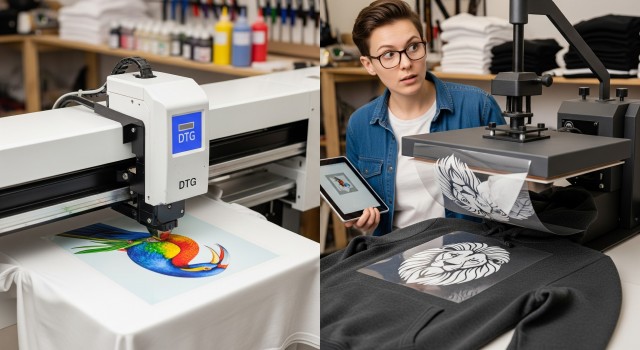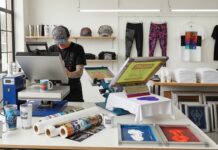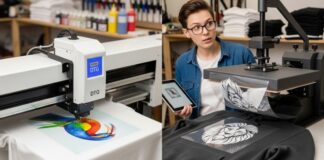Beyond print quality, the real difference lies in fabric versatility and comfort—DTF printing works across materials, while DTG offers soft, breathable results on cotton apparel.
(Isstories Editorial):- Charlotte, North Carolina Nov 5, 2025 (Issuewire.com) – As the custom apparel market surges, creators and entrepreneurs are faced with an increasingly important decision: should they print with Direct-to-Garment (DTG) or Direct-to-Film (DTF)? Each method offers unique advantages in quality, cost, and flexibility. Printful, a leading print-on-demand and fulfillment company, is helping creators understand the differences and choose the method that fits their designs, fabrics, and customers best.
More on Isstories:
- Printful Helps Creators Understand the Pros and Cons of DTG vs. DTF Printing to Choose the Best Method for Their Brand
- AMD Trailer Rental Expands Fleet to Serve North Texas with Reliable Trailer Rental Solutions
- Printful Helps Creators Understand the Difference Between Sublimation and Screen Printing to Build Better Brands
- Holly J. Moore, Recognized by BestAgents.us as a 2025 Top Agent
- Todd Braufman, Recognized by BestAgents.us as a 2025 Top Agent
According to Grand View Research, the U.S. custom t-shirt printing market is expected to exceed $10 billion by 2027, fueled by independent creators, influencer brands, and eCommerce entrepreneurs. With this rapid growth, understanding print technology is key to launching successful, scalable businesses.
Printful: Empowering Creators With Smarter Printing Choices
Printful offers both DTG and its enhanced in-house Direct-to-Film technology, DTFlex, providing creators with the flexibility to produce on-demand apparel that fits every niche–from soft cotton tees to vibrant activewear. Through seamless integrations with platforms like Shopify, Etsy, and WooCommerce, creators can publish, sell, and ship products worldwide without handling inventory or logistics.
“DTG and DTF both deliver exceptional print quality, the best method simply depends on your material, artwork, and goals,” said Davis Srmi, Director of Growth Marketing at Printify. “Printful makes it easy for creators to test both options, compare results, and scale their winning products, all without upfront investment.”
DTG vs. DTF: Breaking Down the Differences
– Direct-to-Garment (DTG) printing uses water-based inks jetted directly onto cotton or natural fibers, creating soft, breathable designs that feel embedded in the fabric. It’s ideal for bold, simple graphics and short-run production, making it a favorite among small brands and on-demand sellers.
– Direct-to-Film (DTF) printing, on the other hand, transfers designs from a printed film onto fabric using heat and adhesive powder. Printful’s DTFlex method works across cotton, polyester, fleece, nylon, and blends–producing crisp, durable prints with vibrant color depth, even on dark or synthetic materials.
While DTG offers an authentic, “ink-in-fabric” feel perfect for everyday wear, DTF excels in versatility and detail, supporting intricate, multi-color artwork and photographic designs.
U.S. Creators Finding the Right Fit
In Brooklyn, NY, Alex, a streetwear designer, shifted from DTG to DTF for his dark, polyester-heavy collection. By doing so, he achieved sharper micro-details and improved durability, boosting repeat purchases by 32% and cutting returns related to print quality.
Meanwhile, in Phoenix, AZ, Riley, a fitness entrepreneur, launched a hybrid collection through Printful: DTG-printed cotton tees and DTF-printed leggings and jerseys. The mix paid off. Within two months, her online store surpassed $28,000 in revenue, with DTF activewear driving higher profits and DTG tees leading overall sales volume.
Sustainability at the Core
Both methods support Printful’s commitment to sustainability. DTG uses Kornit digital printers, which produce near-zero wastewater and use non-toxic, vegan inks. DTFlex employs water-based inks and recyclable transfer films, allowing for on-demand production that eliminates overstock and waste.
“Every printing decision carries an environmental impact,” said Srmi. “Our mission is to provide creators with sustainable, on-demand options – so they can grow their business without compromising on quality or conscience.”
Choosing the Right Printing Method
Printful recommends that creators consider three key factors when deciding between DTG and DTF:
- Fabric type: DTG works best on natural materials like cotton; DTF handles synthetics like polyester, nylon, and blends.
- Design complexity: DTF is ideal for detailed, photo-like images; DTG suits bold, minimal graphics.
- Comfort and use: DTF can feel slightly thicker on large prints, while DTG maintains breathability for everyday apparel.
To make the decision easier, creators can order product samples from Printful to compare texture, color, and durability before launching their lines.
The Future of On-Demand Apparel
As the U.S. creator economy grows, hybrid fulfillment, using both DTG and DTF, has become the new norm. Brands can now offer customers the best of both worlds: breathable cotton tees and high-performance activewear, all fulfilled on demand.
“With tools like Printful, creators no longer have to choose between artistry and efficiency,” said Srmi. “They can experiment, diversify, and build brands that stand out in the modern eCommerce landscape.”
About Printful
Founded in 2013, Printful is a global print-on-demand and fulfillment company that helps creators and businesses design, sell, and ship custom products worldwide. With 23 in-house and partner facilities, 400+ customizable products, and advanced printing technology including DTG, DTF, and embroidery, Printful empowers entrepreneurs to scale without inventory, upfront costs, or logistical stress.
To learn more about Printful’s DTG and DTF printing options or to start your own on-demand store, visit www.printful.com.
Printful Latvia AS
*****@printful.com
Raiņa bulvāris 25, Rīga, LV-1050,Latvija
http://printful.com
This article was originally published by IssueWire. Read the original article here.

































